11 years later, fate of Fukushima reactor cleanup uncertain
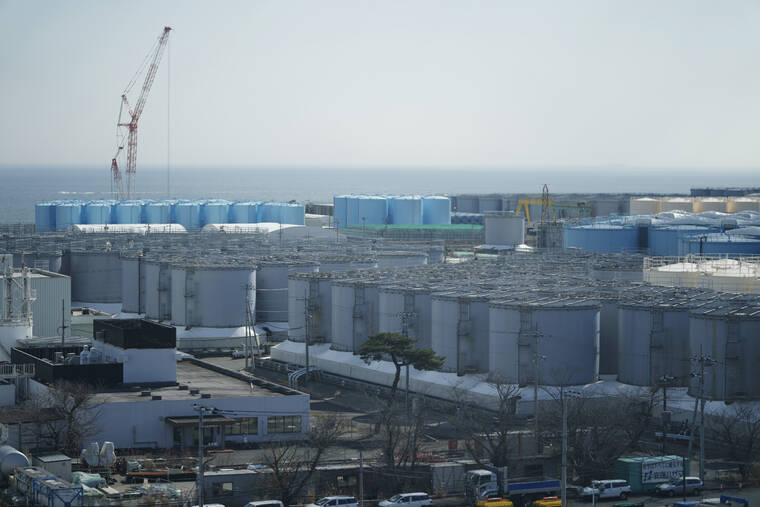
Tanks storing treated radioactive water after it was used to cool the melted fuel are seen at the Fukushima Daiichi nuclear power plant, run by Tokyo Electric Power Company Holdings (TEPCO), in Okuma town, northeastern Japan, on March 3. The government has announced plans to release the water after treatment and dilution to well below the legally releasable levels through a planned undersea tunnel at a site about 1 kilometer offshore. (AP Photo/Hiro Komae)
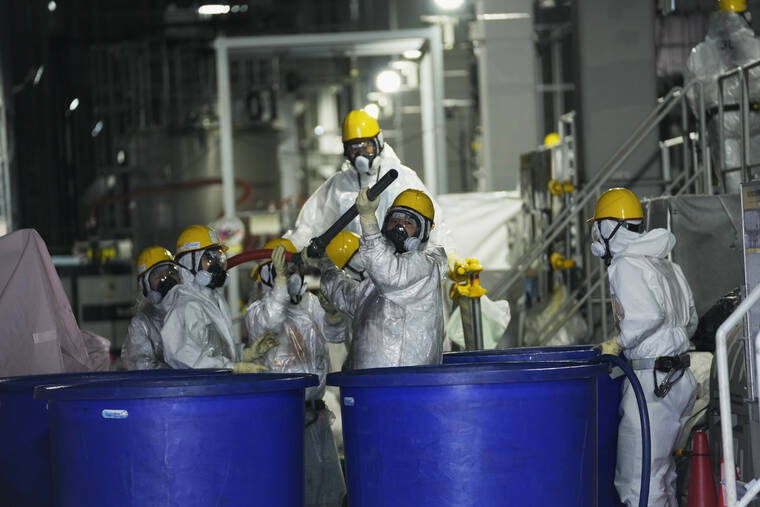
Men in hazmat suits work inside a facility with equipment to remove radioactive materials from contaminated water at the Fukushima Daiichi nuclear power plant, run by Tokyo Electric Power Company Holdings (TEPCO), in Okuma town, northeastern Japan, Thursday, March 3, 2022. The government has announced plans to release the water after treatment and dilution to well below the legally releasable levels through a planned undersea tunnel at a site about 1 kilometer offshore. (AP Photo/Hiro Komae)
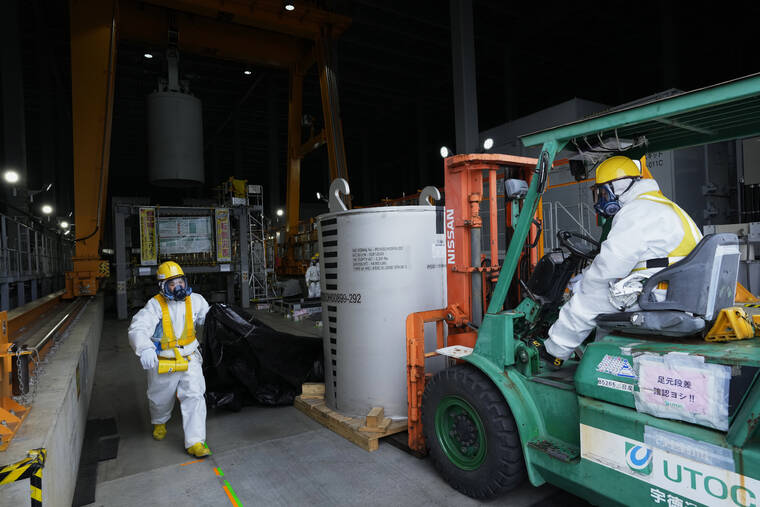
Men in hazmat suits work inside a facility with equipment to remove radioactive materials from contaminated water at the Fukushima Daiichi nuclear power plant, run by Tokyo Electric Power Company Holdings (TEPCO), in Okuma town, northeastern Japan, on March 3. The government has announced plans to release the water after treatment and dilution to well below the legally releasable levels through a planned undersea tunnel at a site about 1 kilometer offshore. (AP Photo/Hiro Komae)
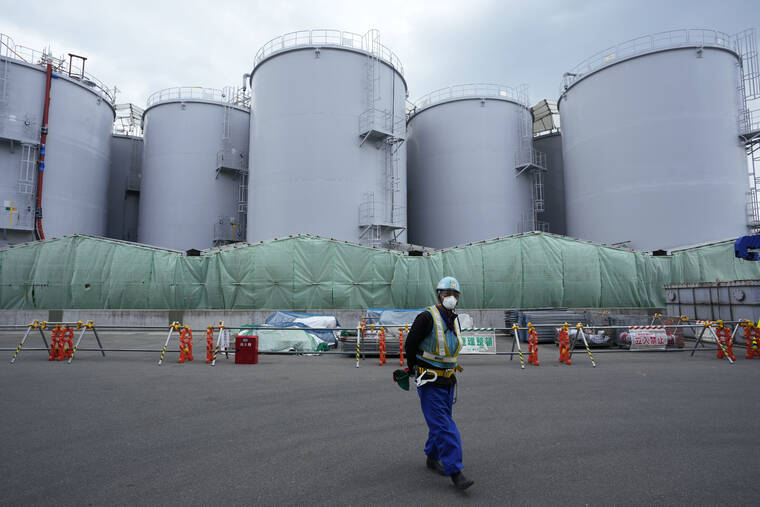
A worker helps direct a truck driver as he stands near tanks, background, that will be used to store treated radioactive water after it was used to cool down melted fuel at the Fukushima Daiichi nuclear power plant, run by Tokyo Electric Power Company Holdings (TEPCO), in Okuma town, northeastern Japan, Thursday, March 3, 2022. Treated radioactive water is stored in tanks at the power station. The government has announced plans to release the water after treatment and dilution to well below the legally releasable levels through a planned undersea tunnel at a site about 1 kilometer offshore. (AP Photo/Hiro Komae)
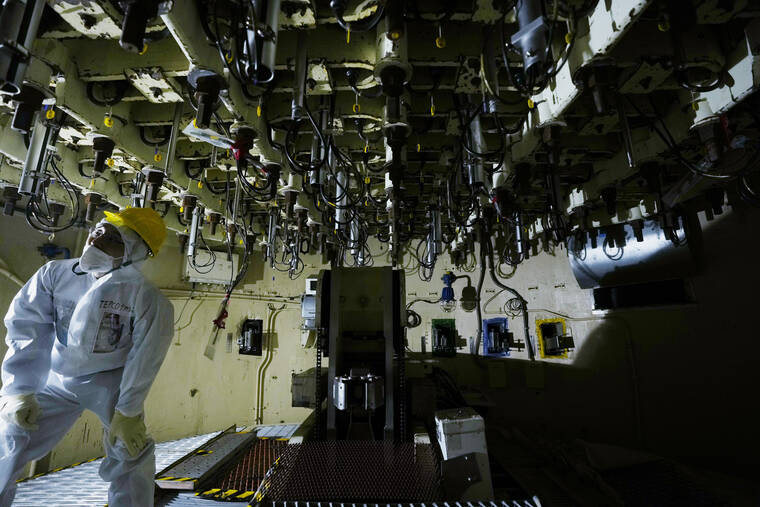
One of the Tokyo Electric Power Company Holdings (TEPCO) employees speaks as they take AP journalists to the area under the Unit 5 reactor pressure vessel, which survived the earthquake-triggered tsunami in 2011, at the Fukushima Daiichi nuclear power plant, run by TEPCO, in Futaba town, northeastern Japan, Thursday, March 3, 2022. The government has set a decommissioning roadmap aiming for completion in 29 years. (AP Photo/Hiro Komae)
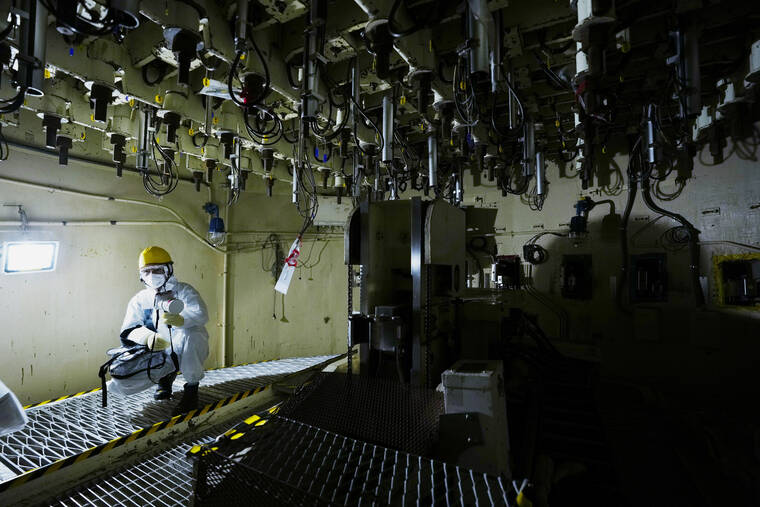
One of the Tokyo Electric Power Company Holdings (TEPCO) employees holds a radiation counter as they take AP journalists to the area under the Unit 5 reactor pressure vessel, which survived the earthquake-triggered tsunami in 2011, at the Fukushima Daiichi nuclear power plant, run by TEPCO, in Futaba town, northeastern Japan, Thursday, March 3, 2022. The government has set a decommissioning roadmap aiming for completion in 29 years. (AP Photo/Hiro Komae)
OKUMA, Japan — Eleven years after the Fukushima Daiichi nuclear power plant was ravaged by a meltdown following a massive earthquake and tsunami, the plant now looks like a sprawling construction site. Most of the radioactive debris blasted by the hydrogen explosions has been cleared and the torn buildings have been fixed.
OKUMA, Japan — Eleven years after the Fukushima Daiichi nuclear power plant was ravaged by a meltdown following a massive earthquake and tsunami, the plant now looks like a sprawling construction site. Most of the radioactive debris blasted by the hydrogen explosions has been cleared and the torn buildings have been fixed.
During a recent visit by journalists from The Associated Press to see firsthand the cleanup of one of the world’s worst nuclear meltdowns, helmeted men wore regular work clothes and surgical masks, instead of previously required hazmat coveralls and full-face masks, as they dug near a recently reinforced oceanside seawall.
Workers were preparing for the planned construction of an Olympic pool-sized shaft for use in a highly controversial plan set to begin in the spring of 2023 to gradually get rid of treated radioactive water — now exceeding 1.3 million tons stored in 1,000 tanks — so officials can make room for other facilities needed for the plant’s decommissioning.
Despite the progress, massive amounts of radioactive melted fuel remain inside of the reactors. There’s worry about the fuel because so much about its condition is still unknown, even to officials in charge of the cleanup.
Nearly 900 tons of melted nuclear fuel remain inside the three damaged reactors, and its removal is an unprecedented challenge involving 10 times the amount of damaged fuel removed in the Three Mile Island cleanup following its 1979 partial core melt.
The government has set a decommissioning roadmap aiming for completion in 29 years.
The challenge of removing melted fuel from the reactors is so daunting that some experts now say that setting a completion target is impossible, especially as officials still don’t have any idea about where to store the waste.
Nuclear Regulation Authority Chairman Toyoshi Fuketa said recently that extra time would be needed to determine where and how the highly radioactive waste removed from the reactors should be stored.
Japan has no final storage plans even for the highly radioactive waste that comes out of normal reactors. Twenty-four of the country’s 60 reactors are designated for decommissioning, mostly because of the high cost needed to meet safety standards set up in the wake of the Fukushima disaster.
On March 11, 2011, a magnitude 9.0 earthquake caused a tsunami 17 meters (56 feet) high that slammed into the coastal plant, destroying its power supply and cooling systems, causing reactors No. 1, 2 and 3 to melt and spewing massive amounts of radiation. Three other reactors were offline and survived, though a fourth building suffered hydrogen explosions.
The spreading radiation caused some 160,000 residents to evacuate. Parts of the surrounding neighborhood are still uninhabitable.
The melted cores in Units 1, 2 and 3 largely fell to the bottom of their primary containment vessels, together with control rods and other equipment, some possibly penetrating or mixing with the concrete foundation, making the cleanup extremely difficult.
Probes of the melted fuel must rely on remote-controlled robots carrying equipment such as cameras and dosimeters — which measure radiation — because radiation levels in those areas are still fatally high for humans.
In February, a remote-operated submersible robot entered the Unit 1 primary containment vessel, its first internal probe since a failed 2017 attempt. It captured limited images of what are believed to be mounds of melted fuel rising from the concrete floor.
Probes have moved ahead at Unit 2, where TEPCO plans to send in an extendable robotic arm later this year to collect melted fuel samples.
TEPCO Chief Decommissioning Officer Akira Ono said in a recent online interview that robotic probes at Unit 1 and 2 this year are a major “step forward” in the decades-long cleanup.
“It’s like we have finally come to the starting line,” Ono said. “Before, we didn’t even know which way we were supposed to go.”
Ono said the Unit 2 melted fuel test removal will start from a granule or two, all of which will be sent for lab analysis, meaning a storage facility won’t be necessary until larger amounts are hauled out. Even a tiny amount would provide valuable data for research and development of fuel and debris removal technology for all three reactors, he said.
Hideyuki Ban, the co-founder of the Citizens’ Nuclear Information Center who previously served on government nuclear safety panels, proposes the underground burial of solidified treated water for stable long-term storage, while entombing the three reactors for several decades — like Chernobyl — and waiting for radioactivity to decrease for better safety and access for workers instead of rushing the cleanup.
Since the disaster, contaminated cooling water has constantly escaped from the damaged primary containment vessels into the reactor building basements, where it mixes with groundwater and rainwater that seep in.
The water is pumped up and treated, partly recycled as cooling water, with the remainder stored in 1,000 huge tanks crowding the plant. The tanks will be full at 1.37 million tons by next spring, TEPCO says.
The government has announced plans to release the water after treatment and dilution to well below the legally releasable levels through a planned undersea tunnel at a site about 1 kilometer offshore. The plan has faced fierce opposition from local residents, especially fishermen concerned about further damage to the area’s reputation.
TEPCO and government officials say tritium, which is not harmful in small amounts, is inseparable from the water, but all other 63 radioactive isotopes selected for treatment can be reduced to safe levels, tested and further diluted by seawater before release.
Scientists say the health impact from consuming tritium through the food chain could be greater than drinking it in water, and further studies are needed.
At one of the water treatment facilities where radiation levels are much higher, a team of workers in full protective gear handled a container filled with highly radioactive slurry. It had been filtered from the contaminated water that’s been continuously leaking from the damaged reactors and pumped up from their basements since the disaster. Large amounts of slurry and solid radioactive waste also accumulate in the plant.
Radiation levels have fallen significantly after decontamination since the disaster, and full protection gear is only needed in limited areas, including in and around the reactor buildings.
On a recent visit, AP journalists used cotton gloves, goggles, a head cover and surgical masks to tour low-radiation areas.
Additional protection, including hazmat coveralls and double rubber gloves, was required when the journalists entered the Unit 5 primary containment vessel and stood on the grating of the pedestal, a structure beneath the defueled core, where officials explained the concept of using robotic probes in No. 1 and 2 reactors.
TEPCO has emptied spent fuel from the No. 3 and No. 4 reactor pools, but removal at the No. 1 and 2 reactors has been delayed several years because of high radiation and contaminated debris, posing concerns of a spent fuel meltdown in case another major quake caused water loss and overheating.
Futaba Mayor Shiro Izawa says the Fukushima Daiichi plant must be safely and fully decommissioned “to make our hometown a safe and livable place again.” Izawa said he wants the government to “wipe out the (region’s) negative image” by tackling the safe cleanup, which is a prerequisite for the town’s reconstruction.


